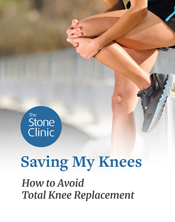Loose Body in the Knee Joint
It is important to remove loose bodies early to avoid knee cartilage damage.
What Is a Loose Body in the Knee?
Loose bodies in the knee joint are small fragments of cartilage or bone that move freely around the knee in joint fluid, or synovium. They can hinder the joint moment by getting caught in flexion and extension movements. The loose bodies can vary in size from a few millimeters (such as the size of a small pill) to a few centimeters (the size of a quarter). The fragments can lead to damage to the articular cartilage, causing osteoarthritis.
Symptoms and Causes of Loose Bodies in the Knee
Symptoms
- The feeling of something moving in the knee.
- Knee locking as though something is blocking it.
Causes
- Injury to cartilage during trauma or sports can lead to the formation of a loose body.
- Osteoarthritis or Charcot's disease, but the secondary cause is direct or indirect trauma.
- Fibrinous loose bodies in case of inflammatory conditions of the knee.
- Synovial chondromatosis (also known as synovial osteochondromatosis) is a rare condition in which the synovium grows abnormally and produces nodules composed of cartilage.
Examination and Diagnosis
X-ray: A loose body is typically diagnosed with an X-ray. In most cases, the traumatic loose body has a bone chip with it or a big chunk of cartilage easily seen on an X-ray.
MRI: The best way to see the location and character of a loose body is with an MRI. When the loose body is just cartilage or in the case of synovial chondromatosis, an MRI is the best non-radiation diagnostic tool to assess the whole knee joint. It is a useful preoperative tool to see the size, number, and location of the loose bodies.
CT scan: This is rarely used but can give details about the loose body when fracture or bone fragments are expected.
Non-Surgical and Surgical Treatments for Loose Bodies
Non-surgical options for managing a loose body are limited. Because loose bodies cause mechanical symptoms, lasting relief usually requires removal. In the meantime, physical therapy and anti-inflammatory medications may help reduce discomfort and maintain joint flexibility.
Arthroscopy
The gold standard today is to remove all loose bodies by arthroscopy, popularly known as “clean out" arthroscopies. It is a minimally invasive procedure that allows the surgeon to look directly inside the knee, confirm the presence of a loose body, and check for cartilage damage. Because it also enables treatment during the same procedure, it is considered the most effective diagnostic and therapeutic option.
Open Arthrotomy
This procedure is rarely needed today because arthroscopy is usually sufficient. However, it may be recommended if the loose bodies are very large or numerous, or if there is extensive involvement of the joint lining (synovium).

